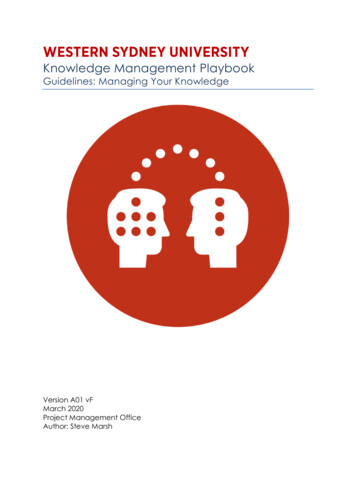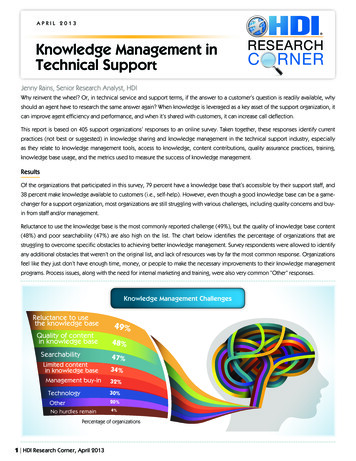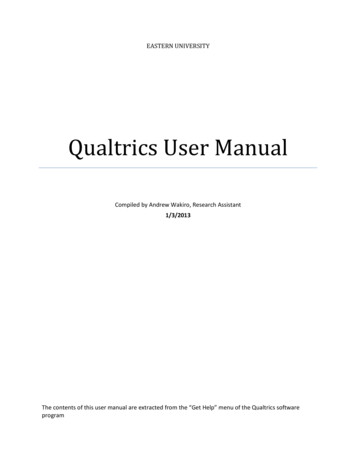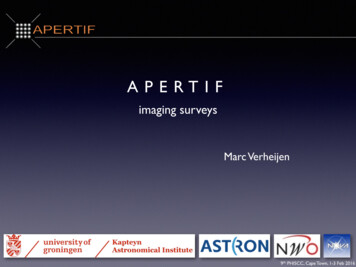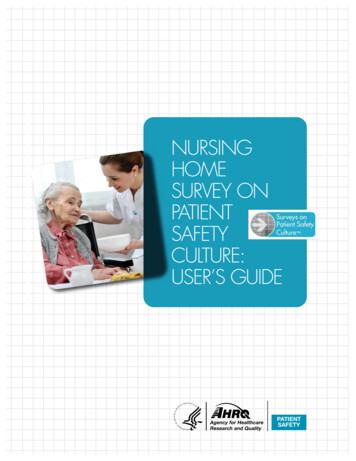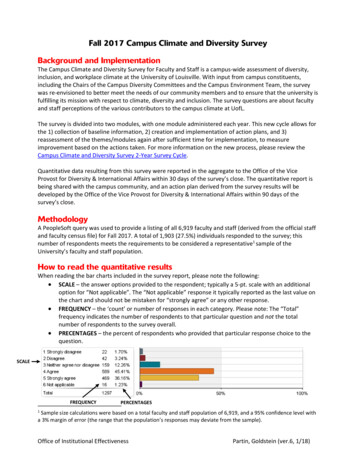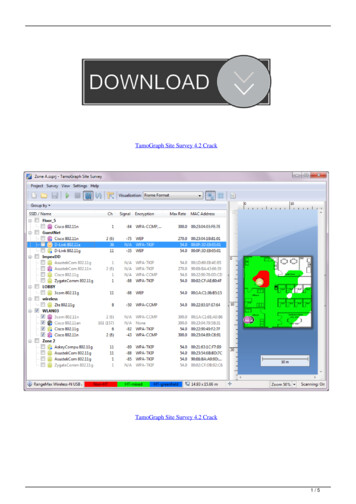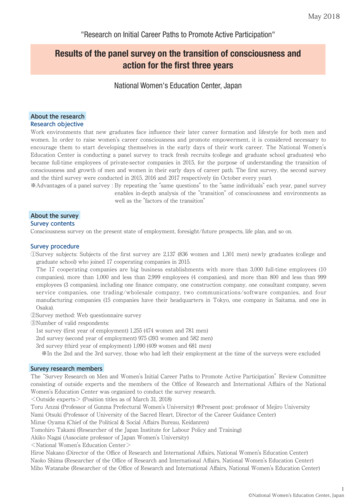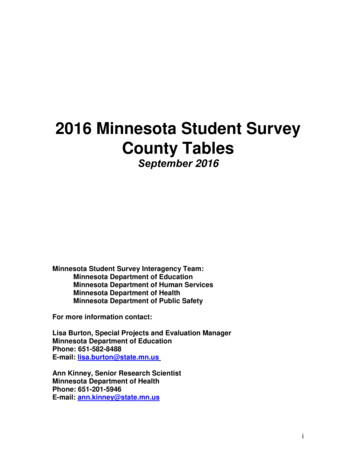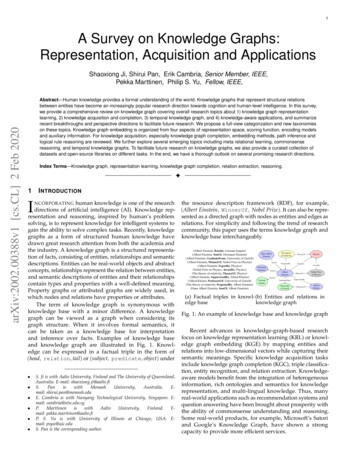
Transcription
1A Survey on Knowledge Graphs:Representation, Acquisition and ApplicationsarXiv:2002.00388v1 [cs.CL] 2 Feb 2020Shaoxiong Ji, Shirui Pan, Erik Cambria, Senior Member, IEEE,Pekka Marttinen, Philip S. Yu, Fellow, IEEE,Abstract—Human knowledge provides a formal understanding of the world. Knowledge graphs that represent structural relationsbetween entities have become an increasingly popular research direction towards cognition and human-level intelligence. In this survey,we provide a comprehensive review on knowledge graph covering overall research topics about 1) knowledge graph representationlearning, 2) knowledge acquisition and completion, 3) temporal knowledge graph, and 4) knowledge-aware applications, and summarizerecent breakthroughs and perspective directions to facilitate future research. We propose a full-view categorization and new taxonomieson these topics. Knowledge graph embedding is organized from four aspects of representation space, scoring function, encoding modelsand auxiliary information. For knowledge acquisition, especially knowledge graph completion, embedding methods, path inference andlogical rule reasoning are reviewed. We further explore several emerging topics including meta relational learning, commonsensereasoning, and temporal knowledge graphs. To facilitate future research on knowledge graphs, we also provide a curated collection ofdatasets and open-source libraries on different tasks. In the end, we have a thorough outlook on several promising research directions.Index Terms—Knowledge graph, representation learning, knowledge graph completion, relation extraction, reasoning.F1I NTRODUCTIONINCORPORATING human knowledge is one of the researchthe resource description framework (RDF), for example,directions of artificial intelligence (AI). Knowledge rep- (Albert Einstein, WinnerOf, Nobel Prize). It can also be repreresentation and reasoning, inspired by human’s problem sented as a directed graph with nodes as entities and edges assolving, is to represent knowledge for intelligent systems to relations. For simplicity and following the trend of researchgain the ability to solve complex tasks. Recently, knowledge community, this paper uses the terms knowledge graph andgraphs as a form of structured human knowledge have knowledge base interchangeably.drawn great research attention from both the academia and(Albert Einstein, BornIn, German Empire)the industry. A knowledge graph is a structured representa(Albert Einstein, SonOf, Hermann Einstein)tion of facts, consisting of entities, relationships and semantic(Albert Einstein, GraduateFrom, University of Zurich)(Albert Einstein, WinnerOf, Nobel Prize in Physics)descriptions. Entities can be real-world objects and abstract(Albert Einstein, ExpertIn, Physics)(Nobel Prize in Physics, AwardIn, Physics)concepts, relationships represent the relation between entities,(The theory of relativity, TheoryOf, Physics)(Albert Einstein, SupervisedBy, Alfred Kleiner)and semantic descriptions of entities and their relationships(Alfred Kleiner, ProfessorOf, University of Zurich)contain types and properties with a well-defined meaning.(The theory of relativity, ProposedBy, Albert Einstein)(Hans Albert Einstein, SonOf, Albert Einstein)Property graphs or attributed graphs are widely used, in(a) Factual triples in knowl- (b) Entities and relations inwhich nodes and relations have properties or attributes.edge baseknowledge graphThe term of knowledge graph is synonymous withknowledge base with a minor difference. A knowledge Fig. 1: An example of knowledge base and knowledge graphgraph can be viewed as a graph when considering itsgraph structure. When it involves formal semantics, itRecent advances in knowledge-graph-based researchcan be taken as a knowledge base for interpretationfocuson knowledge representation learning (KRL) or knowland inference over facts. Examples of knowledge baseand knowledge graph are illustrated in Fig. 1. Knowl- edge graph embedding (KGE) by mapping entities andedge can be expressed in a factual triple in the form of relations into low-dimensional vectors while capturing their(head, relation, tail) or (subject, predicate, object) under semantic meanings. Specific knowledge acquisition tasksinclude knowledge graph completion (KGC), triple classification, entity recognition, and relation extraction. Knowledge S. Ji is with Aalto University, Finland and The University of Queensland, aware models benefit from the integration of heterogeneousAustralia. E-mail: shaoxiong.ji@aalto.fiinformation, rich ontologies and semantics for knowledge ion, and multi-lingual knowledge. Thus, manymail: shirui.pan@monash.edu E. Cambria is with Nanyang Technological University, Singapore. E- real-world applications such as recommendation systems andmail: cambria@ntu.edu.sgquestion answering have been brought about prosperity with P.MarttineniswithAaltoUniversity,Finland.Ethe ability of commonsense understanding and reasoning.mail: pekka.marttinen@aalto.fi P. S. Yu is with University of Illinois at Chicago, USA. E- Some real-world products, for example, Microsoft’s Satorimail: psyu@uic.eduand Google’s Knowledge Graph, have shown a strong S. Pan is the corresponding author.capacity to provide more efficient services.Hans AlbertEinsteinSonOfHermannEinsteinSonOfThe theoryof BornInGermanEmpireGraduateFromUniversityof ZurichWinnerOfPhysicsAwardInNobel Prizein PhysicsSupervisedByProfessorOfAlfredKleiner
2To have a comprehensive survey of current literatures,this paper focuses on knowledge representation whichenriches graphs with more context, intelligence and semantics for knowledge acquisition and knowledge-awareapplications. Our main contributions are summarized asfollows.back to the General Problem Solver [2] in 1959. The knowledge base is firstly used with knowledge-based systemsfor reasoning and problem solving. MYCIN [3] is one ofthe most famous rule-based expert systems for medicaldiagnosis with a knowledge base of about 600 rules. Later,the community of human knowledge representation sawthe development of frame-based language, rule-based, andhybrid representations. Approximately at the end of thisperiod, the Cyc project1 began, aiming at assembling humanknowledge. Resource description framework (RDF)2 andWeb Ontology Language (OWL)3 were released in turn, andbecame important standards of the Semantic Web4 . Then,many open knowledge bases or ontologies were publishedsuch as WordNet, DBpedia, YAGO, and Freebase. Stokmanand Vries [4] proposed a modern idea of structure knowledgein a graph in 1988. However, it was in 2012 that the conceptof knowledge graph gained great popularity since its firstlaunch by Google’s search engine5 , where the knowledgefusion framework called Knowledge Vault [5] was proposedto build large-scale knowledge graphs. A brief road map ofknowledge base history is illustrated in Appendix AComprehensive review. We conduct a comprehensive review on the origin of knowledge graph andmodern techniques for relational learning on knowledge graphs. Major neural architectures of knowledgegraph representation learning and reasoning areintroduced and compared. Moreover, we provide acomplete overview of many applications on differentdomains. Full-view categorization and new taxonomies. Afull-view categorization of research on knowledgegraph, together with fine-grained new taxonomies arepresented. Specifically, in the high-level we reviewknowledge graph in three aspects: KRL, knowledgeacquisition, and knowledge-aware application. ForKRL approaches, we further propose fine-grainedtaxonomies into four views including representation space, scoring function, encoding models, and 2.2 Definitions and Notationsauxiliary information. For knowledge acquisition, Most efforts have been made to give a definition by deKGC is reviewed under embedding-based ranking, scribing gen
a collection of knowledge graph datasets and open-source implementations can be found in the appendices. 2 OVERVIEW 2.1 A Brief History of Knowledge Bases Knowledge representation has experienced a long-period history of development in the fields of logic and AI. The idea of graphical knowledge representation firstly dated



